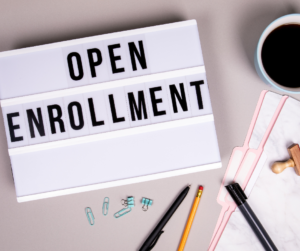
by admin | Oct 11, 2022 | Employee Benefits, Open Enrollment
 Choosing the right benefits during open-enrollment season is so important and can help save money. It can also give individuals and families broader support with their health. Benefits like medical coverage are particularly important with high inflation having such a big impact on people’s budgets.
Choosing the right benefits during open-enrollment season is so important and can help save money. It can also give individuals and families broader support with their health. Benefits like medical coverage are particularly important with high inflation having such a big impact on people’s budgets.
A survey by UnitedHealthcare found that nearly 40% of employees devote less than one hour to the open enrollment process. It is crucial to carefully analyze your benefits during open enrollment as any decisions you make will likely be locked for the year until the next open enrollment period. Don’t rush into open enrollment without carefully considering your options!
Here are some tips to ensure you make the most of your open enrollment:
Be Prepared
Open enrollment typically lasts for a short period (2-4 weeks) so knowing what you need to do ahead of time can be a big stress reliever. A good starting point is to consider how your needs have changed since last year. For example, maybe you got married or received a raise. These changes may require a change in coverage, whether it be for life, health or disability insurance, and it is important to consider how these or any other expected life changes will impact your insurance needs.
Review Any Changes Made by Your Employer
It is common for employers make changes to plans and premiums to keep up with the times. When you receive your open enrollment packet to review plan options, it is important to consider all aspects of coverage and the total cost of coverage. The total cost is impacted by the deductibles, premiums, co-insurance and maximum out-of-pocket expenses.
Take note of whether your employer made any changes in providers. If this happens, your current physician or dentist may be out-of-network which will result in out-of-network costs or denied claims.
Review Your Insurance Options
The largest portion of employer benefits is health insurance so it is important to choose the plan that is best for you and your family. Important questions to ask are: how often do you have medical expenses? Are lower premiums or lower out-of-pocket costs more important to you? Do you take expensive prescription drugs? Can you afford hefty out-of-pocket costs if there is an emergency?
There are 3 main plan types:
- Preferred Provider Organization (PPO)
PPO’s are a popular choice since they allow you to see any doctor or specialist and don’t require a referral from your primary care physician (PCP) to see a specialist. However, PPO premiums are usually much more than other plans. To help reduce costs, remember that using in-network providers and specialists who are part of your PPO network will save you money.
- Health Maintenance Organization (HMO)
HMOs have lower premiums than PPOs but they require you to stay in-network. You will also need a referral from your PCP to see a specialist. The idea is that the PCP coordinates your care.
- High Deductible Health Plan (HDHP)
Another low-cost option is a high-deductible health plan. What sets HDHPs apart from other plans is their low premiums and high deductibles. That means you won’t have to pay as much each month for premiums but you will need to pay more of the healthcare costs when you need services. To help you pay for the bigger deductible, employers usually pair an HDHP with a health savings account (HSA), which allows you to save for medical expenses, including deductibles and copays.
Learn How FSAs, HRAs, and HSAs Differ
Many employers offer accounts that help you save for medical expenses:
- Flexible Spending Account (FSA)
You decide how much pre-tax money to put into the employer owned account through payroll deductions and then you can use that money to pay for out-of-pocket medical expenses. You lose that money if you change jobs or don’t use it by the end of the year.
- Health Savings Account (HSA)
Connected to a HDHP, an HSA lets you set aside money on a pre-tax basis to pay for qualified medical expenses. The account is yours, so you keep it if you change jobs. The money rolls over each year so you don’t have to worry about “using it or losing it.”
- Health Reimbursement Arrangement (HRA)
An HRA is similar to an HSA except that the employer owns the account so you can’t take it with you when you change jobs. You’re able to contribute money for medical expenses just like an HSA or FSA. Money can also be carried over to the next year like an HSA.
Open enrollment is an important time of year and is worth investing some time and energy to decide what is best for you and your family. Health insurance is one of the most important purchases you make. By doing your homework and taking the time to carefully consider your options, you’ll find the plan that is right for you!

by admin | Oct 5, 2022 | Health Insurance, Open Enrollment
 For most employers, employee benefits represent a significant portion of their overall budget and a critical part of their employee recruitment and retention strategy. Benefits vary from employer to employer but can range from medical or dental insurance to flexible spending accounts, life and disability insurance, and more. The annual process of renewing those benefits involves a great deal of work, most of which is unseen by employees.
For most employers, employee benefits represent a significant portion of their overall budget and a critical part of their employee recruitment and retention strategy. Benefits vary from employer to employer but can range from medical or dental insurance to flexible spending accounts, life and disability insurance, and more. The annual process of renewing those benefits involves a great deal of work, most of which is unseen by employees.
As you finalize your benefits lineup for the next year and hold your first open enrollment meeting, we’re sharing five tips related to common issues we hear from Mineral customers each year.
There are different ways to handle benefit elections. They range from affirmative or “active” elections that require everyone to select options, to evergreen “rolling” elections that only require employees to take action if they want to make changes. There are also many other options in between. Which option an employer chooses depends on their strategy for participation, the types of benefits they offer, state wage deduction rules, and other factors. Before you get started with benefits elections:
- Double check to confirm that any election rules you are using during open enrollment match what was discussed with your insurance carrier or third-party administrator (TPA), as well as matching what you say to employees in plan materials and open enrollment communications.
- Decide what happens if an employee who is enrolled in coverage takes no action during open enrollment. Will their coverage be dropped? Will some or all of their elections carry over to the next plan year? Clearly communicate the consequences of inaction, if any.
Don’t Forget About COBRA!
Federal COBRA applies to most employers that offer group health coverage and that have 20 or more employees. COBRA allows employees (and certain dependents) who experience qualifying events during the plan year to continue coverage for a period of time, at their own cost. Many states have similar laws for employers with fewer than 20 employees, often called “mini-COBRA” laws. Individuals who have elected federal COBRA have many of the same rights as active participants and must be provided the option to waive or elect coverage or add or remove dependents as well. To notify employees of their COBRA rights:
- Clarify who is responsible for sending open enrollment information to COBRA qualified beneficiaries. If you administer COBRA in-house, ensure the person responsible knows open enrollment communications should include COBRA qualified beneficiaries.
- If you are using a third-party vendor for COBRA administration, make sure they send any required communications or paperwork to eligible employees. If the vendor doesn’t do this, the responsibility generally falls on the plan sponsor (the employer).
Leverage Attention
The open enrollment period happens when employees are paying closer attention to benefit-related topics. Open enrollment meetings and communications can present additional opportunities to gather data and insight into the needs and experiences of participants in your benefit programs. Use this time to:
- Consider including an employee survey or otherwise collecting feedback, even anecdotally, on areas of interest or concern. This might include asking for feedback on the open enrollment process and communications. If you hear grumbling about a specific process or hear people express confusion about a particular option, that can be a great way to identify opportunities for education or change. For example, if several people mention in an open enrollment meeting that drug prices are too high, you might decide to send a follow-up communication to remind employees about bulk mail order prescriptions and the additional value that can provide.
- Consider a dependent audit. Dependent audits ensure only eligible individuals are on the plan, which keeps employers in compliance with their plans as written and reduces any unnecessary costs for ineligible dependents. Timing an audit to occur just before or during open enrollment can reduce compliance complications if a dependent is deemed ineligible.
Carefully Review Salary Deduction Agreements
Benefit costs typically change from year to year and most state wage and hour laws require employees to authorize payroll deductions for benefit contributions. Use this time to review your existing deduction agreements and ensure they cover the most current options. Then gather updated deduction agreements from employees. As you review these agreements, consider the following questions:
- Do they clearly indicate the approved amounts to be deducted from pay and the frequency?
- What rights do employees have to choose whether or not their cost share is taken pre-tax or after-tax? If you have a § 125 cafeteria plan in place, confirm the options available so your deduction agreements accurately reflect the choices available to employees.
- Do they address deductions from final pay (e.g., double deductions)? Caution: Cafeteria plan rules do not allow for double deductions from final pay in most cases, and state wage and hour laws can heavily restrict this as well.
Align Processes
Carefully review your electronic or online benefits enrollment systems to confirm the options and language align with the plan rules, and consider the following:
- If you use a universal enrollment form or electronic system, confirm they contain any insurance carrier or TPA required arbitration or enrollment language, so the election is considered valid.
- Put an audit process in place so that, after open enrollment, you can confirm the elections made by employees are transmitted to the carrier/TPA accurately and payroll entries are aligned.
- Provide employees with a confirmation statement that outlines their final election choices and deduction agreements. Also, consider reminding employees to confirm this statement against their first payroll of the new plan year to make sure it reflects their choices. Both steps can go a long way to catching mistakes early, when they are easiest to compliantly correct.
Planning ahead can result in a more effective, streamlined process for the employer and clarity for employees.
By Eeloria Brown
Originally posted on Mineral

by admin | Sep 27, 2022 | Financial Planning
 According to most retirement savings statistics, saving for retirement is something a lot of people put on the backburner. Until it is too late, that is.
According to most retirement savings statistics, saving for retirement is something a lot of people put on the backburner. Until it is too late, that is.
For some people, the reason is that they are simply living paycheck to paycheck, so there isn’t much left to put aside. Others have some leftover money after covering the monthly expenses but aren’t sure how much they need to put in their retirement fund. Retirement is expensive and you need to know how much money you will need each year.
Most experts say your retirement income should be about 80% of your final pre-retirement annual income. That means if you make $100,000 annually at retirement, you need at least $80,000 per year to have a comfortable lifestyle after leaving the workforce.Facts:
- Only half of Americans have calculated how much they need to save for retirement.
- In 2020, more than a quarter of private industry workers with access to a defined contribution plan (such as a 401(k) plan) did not participate.
- The average American spends roughly 20 years in retirement.
Remember…Savings Matters! Here are 6 Ways to Save for Retirement:
1 – Focus on Starting Today – Start saving as much as you can now and let compound interest – the ability of your assets to generate earnings, which are reinvested to generate their own earnings – have an opportunity to work for you. Develop a plan and stick to it.
2 – Take Advantage of Your Employer’s 401(k) plan – Try to save at least 10-15% of your pay in a tax-advantaged retirement account, such as a 401(k). Make sure to increase your contribution or at least set up an auto-escalation so that you put in more each year.
3 – Meet Your Employer’s Match – If you employer offers to match your 401(k) contributions, make sure you contribute enough to take full advantage of the match. For example, an employer may offer to match 50% of employee contributions up to 5% of your salary. That means that if you earn “$50,000 per year and contribute $2,500 to your retirement plan, your employer would add another $1,250. It is essentially free money! Don’t leave it on the table.
4 – Invest in an Individual Retirement Account (IRA) – There are two IRA options: a traditional IRA or a Roth IRA. The taxes from your contributions and withdrawals are different with these two types of IRA’s so be sure to choose the type that is right for you.
5 – Take Advantage of Catch-Up Contributions – Turning 50 years old has some advantages, including being able to contribute more to your retirement account with catch-up contributions. In 2022, you can add an extra $6,500 per year in catch-up contributions, bringing your total 401(k) contributions to $27,000. For either a traditional or a Roth IRA, the annual catch-up amount is $1,000 which boosts your total contribution to $7,000.
6 – Find Out About Your Social Security Benefits – Social Security retirement benefits replace 40% of pre-retirement income for retirement beneficiaries. You can estimate your benefit by using the retirement estimator on the Social Security Administration’s website.
Debra Greenberg, Director of Retirement and Personal Wealth Solutions for Bank of America said, “Recognizing the need to put money away for retirement is the first step.” Understanding how much you want to save and setting goals to achieve your financial goals is vital. Starting too late and saving too little is a common regret among retirees. Making the effort now can help you look forward to your golden years.
Even with these tips, you’ll need more information. Talk to your bank or financial advisor to get practical advice to start saving today!

by admin | Sep 20, 2022 | Hot Topics, Human Resources
 By all accounts, the United States is likely heading into a recession. Already, the country experienced two consecutive quarters of declining gross domestic product (GDP), which is a red flag.
By all accounts, the United States is likely heading into a recession. Already, the country experienced two consecutive quarters of declining gross domestic product (GDP), which is a red flag.
Other signs include inflation, the cooling down of venture capitalist’s investment, a declining stock market, and varying interest rates. However, a strong job market persists, which throws off the usual domino effect, according to CNBC. Still, how people feel about their financial prospects matters, too.
Most Human Resources leaders are preparing for the worst. A recession is marked by an extended downturn in the economy, layoffs, unemployment, and lower consumer spending. For HR, recessions are magnified because they usually face the downsizing of their own department and the need to layoff talent, make due with less, and face the obvious consequences, which include having to constrict budget and lose talent pipelines for succession.
Therefore, Human Resources is usually keen on recession-proofing their business, and many have begun to do just that. Here are some ways to prepare for the coming storm:
Stick to the Budget
The pandemic made employees rethink their lives and shift their priorities. As a result, many were willing to leave the workforce unless employers transformed how they worked. The consequence was the Great Resignation. Whether one likes or hates that title, there is no question that the phenomenon of people quitting and a resulting labor shortage, which is also dependent on changing demographics, are real.
HR responded with signing bonuses and hefty pay raises. They plussed perks and benefits. With an oncoming recession, however, some of these tools for attracting talent must be curtailed or flat out stopped. Those with the future in mind are cutting back and avoiding risk when developing budgets.
Prioritize Employee Engagement and Experience
Smart Human Resources leaders recognize that the pandemic earned them their seat among C-suite executives. Business leaders are well aware that the talent churning out the work is vital to their success.
In many ways, employee engagement and experience is even more important in a recession. If there are layoffs, the people who remain become paramount. At the same time, they are likely overworked and stressed by the economy, not to mention the prospects of their organization. HR should step in and show gratitude and do what it can to keep up morale. Writing thank you cards and lending an ear are affordable ways to connect with workers.
Be Transparent
Transparency is of the utmost importance during a recession. Obviously, organizations keep their plans for layoffs under wraps until the last minute. However, they should be able to offer honesty to the employees who remain.
Obviously, they are going to be concerned for their own future, what these layoffs mean for the future of the company, and how their work life will change from this point on. Will they be doing more work to fill in for those who had been let go? Are there going to be freezes on annual raises? How grave is the situation?
Human Resources is the conduit for communication with workers. HR leaders can communicate forthrightly and encourage executives to do the same. They can set up town halls, similar to the ones they planned during the pandemic, with business leaders in their organization. This kind of approach is crisis management 101.
Be Prepared for Layoffs
Layoffs are already happening at a number of companies, including Peloton, Netflix, and Ford. Google announced a hiring freeze. So, realistic HR leaders will prepare themselves for the possibility of stalemate at best and layoffs at worst. Also, they will avoid layoff mistakes, like informing people they are being let go in a cruel way like, for example, over a group Zoom meeting. While no one wants a recession to happen, smart HR leaders are getting ready for the worst case scenarios.
By Francesca Di Meglio
Originally posted on HR Exchange Network

by admin | Sep 13, 2022 | Hot Topics, Human Resources, Workplace
 Many young employees from Gen Z are taking to TikTok to express their frustration about the workplace and profess their practice of quiet quitting. Essentially, they are remaining at their jobs and still receiving paychecks and benefits, but they are sticking strictly to their the job descriptions and maintaining precise schedules.
Many young employees from Gen Z are taking to TikTok to express their frustration about the workplace and profess their practice of quiet quitting. Essentially, they are remaining at their jobs and still receiving paychecks and benefits, but they are sticking strictly to their the job descriptions and maintaining precise schedules.
On social media, some are bragging about doing the bare minimum because of their disappointment in their employer or simply as a lifestyle choice. Some older workers are suggesting this is a result of laziness or lack of ambition. Many in Gen Z argue that they are simply doing what is expected of them contractually, and nothing more, to maintain work-life balance.
The Phenomenon of Quiet Quitting
More than 3.9 million TikTok posts (and presumably counting) have addressed this phenomenon. Many explain that quiet quitting is really about setting boundaries and improving work-life balance or fighting the proverbial man.
“You’re not quiet quitting,” says Claudia Alick in a TikTok video. “You’re just resisting being stolen from. Unfortunately, that’s how capitalism works. That’s how they make a profit. The profit comes from you not getting paid your full value.”
But some career experts and even other TikTok users suggest that young employees are playing with fire. By never going above and beyond, they are making themselves vulnerable to layoffs at a time when budget is a concern. In addition, they might rule themselves out of promotions down the road.
Emily Smith, a TikTok user, reminds people that their boss might not know all their tasks or how long it takes for them to get everything done. She suggests having a conversation about what to prioritize and how to spread out the deadlines is a better route than quiet quitting. Others suggest this practice is bad news for employers.
“Experts say any lack of motivation among a company’s youngest workers can become a troubling sign. ‘Organizations are dependent on employees doing more than a minimum,'” says Mark Royal, senior director for Korn Ferry Advisory, according to a Korn Ferry blog.
What Should HR Do?
HR leaders should investigate the phenomenon of quiet quitting to determine whether it is happening at their organization. After all, a lack of employee engagement is top of mind in Human Resources. Thirty percent of those who responded to the latest State of HR report said employee engagement and experience is their top priority.
The pandemic forced people to rethink their lifestyle and reprioritize work. For many, family, friends, and personal pursuits have replaced work in the top spot. Some say that quiet quitting is the new checking out. Regardless, the Great Resignation has shown that employers, who do not take these shifts in culture seriously, will pay in a loss of talent.
At the same time, the top consequence of the pandemic, according to the respondents of State of HR, was burnout. That may be why TikTok users are leading the charge to demand better working conditions. Certainly, HR leaders are responding with different benefits, such as unlimited PTO and zen rooms, and policies like devising rules that limit calls and emails outside of work hours.
Even Goldman Sachs, famous for its 100-hour work weeks for associates, is requiring employees to take paid time off. Salesforce is testing work weeks with no meetings. Others are experimenting with four-day work weeks, flexibility in when and where employees work, and company-wide vacation days. This experimentation is part of the transformation of work that everyone is witnessing post pandemic.
The question becomes whether quiet quitting is an afront to employers that will degrade their ability to serve customers and innovate or is simply a new way of working that puts people’s personal lives and wellbeing above everything else. Perhaps, this is just part of the cultural shift and workplace transformation the country has been experiencing since the start of the pandemic.
By Francesca Di Meglio
Originally posted on HR Exchange Network

 Choosing the right benefits during open-enrollment season is so important and can help save money. It can also give individuals and families broader support with their health. Benefits like medical coverage are particularly important with high inflation having such a big impact on people’s budgets.
Choosing the right benefits during open-enrollment season is so important and can help save money. It can also give individuals and families broader support with their health. Benefits like medical coverage are particularly important with high inflation having such a big impact on people’s budgets.



